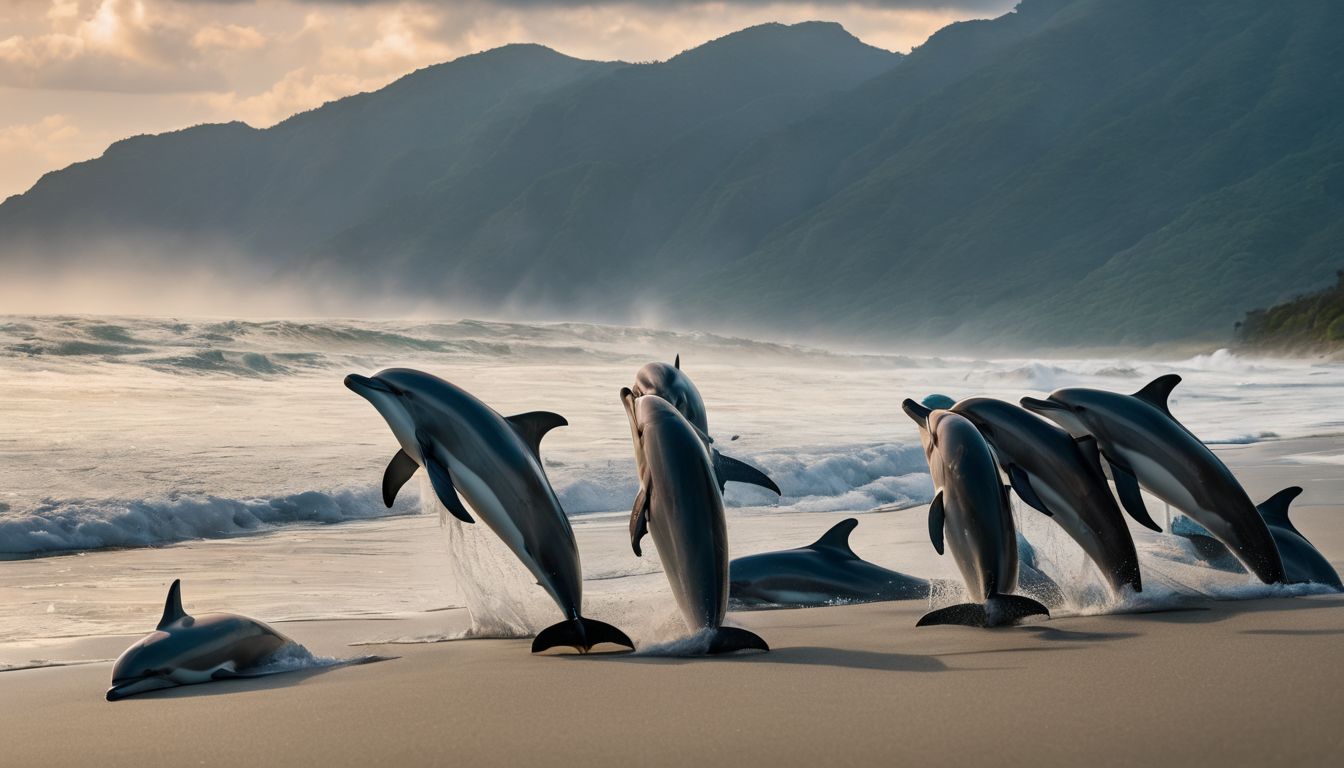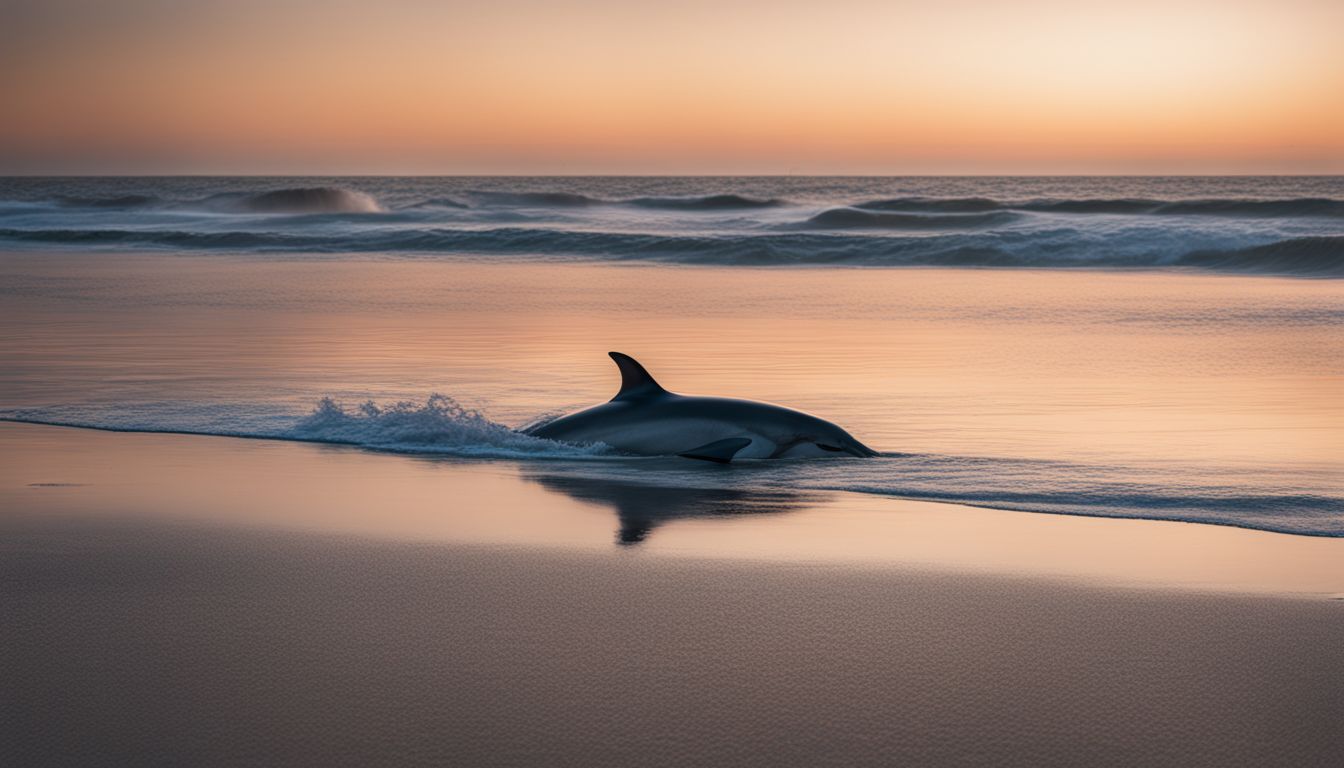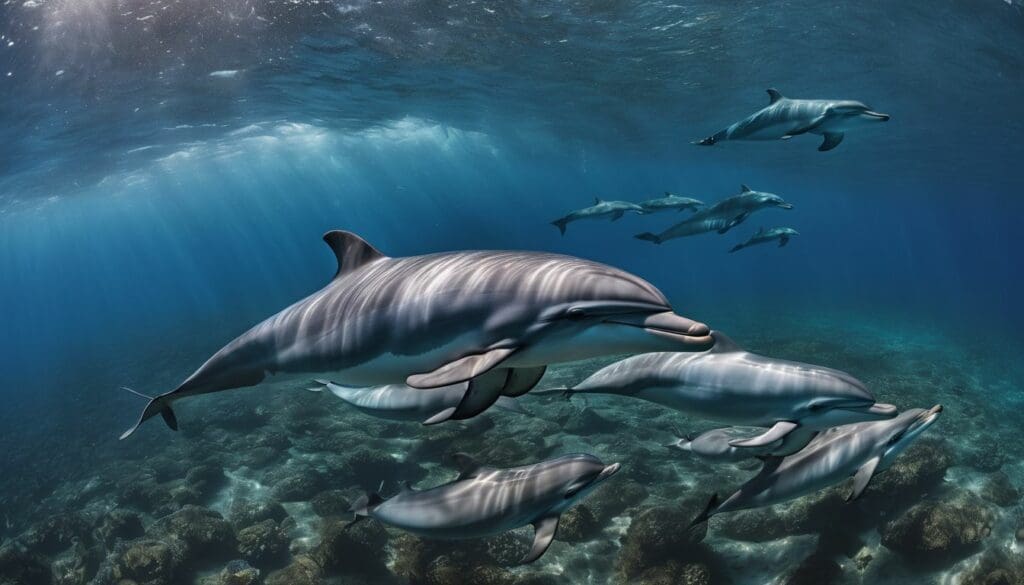The sight of dolphins marooned on our coastlines tugs at the heartstrings, stirring a profound need to fathom why such sagacious beings are rendered so inexplicably vulnerable. The shared distress at these scenes is palpable among us all; it’s a topic close to my own heart as well.
Astonishingly, more than 1,000 cetaceans find themselves beached annually. Our blog aims to gently unravel the mystery shrouding these mass dolphin strandings, shedding light on the causes behind such sorrowful incidents and exploring ways we can extend our helping hand.
Come along with us as we delve into this important issue with both compassion and curiosity.
Key Takeaways
- Dolphins strand for various reasons including environmental changes, human activities like fishing and noise pollution, health issues, social bonding within pods, and navigation errors.
- Mass dolphin strandings occur globally with notable recent events in Ghana with around 100 dolphins in March 2021, Tasmania with 230 in October 2021, New Zealand with approximately 49 in January 2022, and the UK’s North Carolina involving over 200 dolphins in February 2023.
- Rescue teams play a critical role by assessing stranded dolphins’ health, providing medical care if needed, rehabilitating them when possible and releasing them back into the wild equipped with satellite tags to monitor their progress.
- Diseases such as morbillivirus and factors like toxins from harmful algal blooms contribute significantly to disorientation that leads to strandings. Sonar disruptions impair echolocation abilities essential for dolphin navigation.
- Continuous research into each stranding incident enhances our understanding of these phenomena which is vital for marine conservation efforts worldwide.
Understanding Dolphin Strandings

We’re delving into the perplexing world of dolphin strandings, where these intelligent marine mammals unexpectedly beach themselves. It’s a multifaceted issue that sets scientists on a quest to unravel what drives these creatures towards such life-threatening predicaments.
Definition and Overview
Dolphin strandings puzzle us all. These are events where dolphins, along with other cetacean species like pilot whales and false killer whales, find themselves ashore, unable to return to the water.
Often in large groups known as mass strandings, these incidents can involve just one or several dozens of marine mammals facing peril on beaches around the world.
Understanding why these intelligent creatures end up stranded is crucial for their conservation. Factors range from natural to human-induced influences such as noise pollution and ship strikes.
By closely examining dolphin strandings, we aim to protect these essential members of ocean ecosystems from unnecessary harm and preserve nature’s delicate balance.
Factors influencing Dolphin Strandings
- Environmental changes significantly impact dolphin behaviour. Shifts in water temperature or sudden natural events like earthquakes can disorient cetaceans and push them towards the shore.
- Human activities such as fishing can inadvertently entangle dolphins, making it hard for them to swim freely. Struggling to escape nets or lines, they sometimes end up on beaches.
- Undersea noise pollution from ships or active sonar disrupts the natural echolocation abilities dolphins rely on for navigation, possibly leading them to strand.
- Chemical pollutants in the ocean from sources like oil spills or toxic waste may poison dolphins, weakening them and causing disorientation that results in strandings.
- Dolphins chase prey into shallow waters which can be a trap if they cannot find their way back to deeper seas. Getting caught by a falling tide can leave them stranded.
- Health issues play a role; infections such as morbillivirus—a relative of measles—and bacterial infections affect their health, leading to strandings.
- Social bonding within pods means that if one dolphin becomes stranded due to sickness or injury, others may follow, resulting in mass strandings.
- Navigation errors are more common among young cetaceans who might not be as adept at navigating the ever-changing marine landscapes.
Dolphin Strandings: A Worldwide Phenomenon

In every corner of the globe, from the warm beaches of New Zealand to the chilly shores of Nova Scotia, communities bear witness to the heart-wrenching sight of mass dolphin strandings.
These events capture global attention and bewilderment as we struggle to understand what drives these intelligent creatures ashore in such devastating numbers.
Recent Instances of Mass Dolphin Strandings
Dolphin strandings continue to perplex us, presenting a heartbreaking challenge for conservationists around the globe. Here’s a summary of recent mass strandings that have captured international attention:
| Date | Location | Number of Dolphins | Outcome |
|---|---|---|---|
| March 2021 | Ghana | Around 100 | Unexplained deaths |
| October 2021 | Tasmania, Australia | 230 | Rescue efforts launched, with partial success |
| January 2022 | Coromandel, New Zealand | Approx. 49 | Majority perished, few saved |
| February 2023 | Outer Banks, North Carolina, USA | Over 200 | Investigation ongoing, community rallied to assist |
Each instance brings together communities and rescue teams, working tirelessly to understand and respond to these tragic events. We strive to resolve the mystery behind these occurrences, aware that our oceans are sending us an urgent message.
The Role of Rescue Teams in Dolphin Strandings
Our dedicated rescue teams play a crucial role in assessing and aiding stranded dolphins, working tirelessly to rehabilitate and safely return these magnificent creatures back to their ocean home; join us as we delve into their heroic efforts.
https://www.youtube.com/watch?v=K8VbrXC7GVY
Assessment of Stranded Dolphins
We rush to the scene as soon as we hear of a stranded dolphin. Our initial task is to evaluate each animal’s condition carefully. Here’s how we assess stranded dolphins:
- We check the dolphin’s breathing and heart rate first, ensuring they’re stable before any further examination.
- Our team examines the dolphin for visible injuries or signs of illness that might explain their stranding.
- We then record the animal’s length and weight, as these measurements can indicate their health status.
- Assessing skin condition is next; we look at lesions or abnormalities that could be clues to disease or environmental stress.
- To understand if human activities have impacted them, we search for marks from fishing gear or encounters with boats.
- Blood tests are taken to check for infections or diseases, such as toxoplasmosis or diseases related to the rinderpest virus like canine distemper.
- We also test for levels of hydration and nutrition because a well-nourished dolphin has a better chance of survival after release back into the wild.
- Observing behaviour is crucial; how the dolphin reacts to humans can reveal its stress level and overall wellbeing.
- We ensure careful documentation so that details can be shared with organisations, including NOAA Fisheries, contributing to broader research efforts.
Rehabilitation and Release efforts
- We quickly assess each stranded dolphin for injuries or illnesses that may have caused the stranding.
- Our veterinarians provide immediate care to address wounds, dehydration, or other health concerns.
- Dolphins are carefully transported to rehabilitation facilities where they can recover in a safe and controlled environment.
- We monitor their health, behaviour, and eating patterns closely during recovery to ensure they regain strength.
- In collaboration with marine biologists, we evaluate the dolphins’ readiness for release based on strict criteria.
- Before releasing them back into the wild, we often attach satellite tags that allow us to track their movements and survival.
- Education programmes with local communities are set up to raise awareness about preventing future strandings.
- After thorough preparation, we select an appropriate release site that maximises the dolphins’ chances of reintegration.
The Mystery of Mass Dolphin Strandings
We’ll delve into the enigmatic reasons behind mass dolphin strandings, exploring how diseases and environmental factors play a part, urging us all to unravel these marine mysteries further.
Possible Causes: Diseases and Environmental Factors
- Diseases like measles virus affect dolphin populations similarly to how rubeola strikes humans. The infection can disorient dolphins, leading them to beaches instead of the open sea.
- Toxins from harmful algal blooms may poison dolphins. These toxins attack their nervous systems, causing confusion and ultimately stranding.
- Marine debris, including plastic pollution, entangles dolphins. This can result in injuries that prevent them from swimming properly, pushing them towards the coastline.
- Activities involving sonars disrupt dolphin echolocation. These sounds interfere with their natural navigation systems, pushing them into unfamiliar shallow waters.
- Climate change alters ocean temperatures and currents. Dolphins may follow changing fish patterns into danger zones where they become stranded due to unfamiliar terrain or depleting food sources.
- Environmental disasters such as oil spills contaminate dolphin habitats. The chemicals can make dolphins sick and weak, leaving them unable to swim away from beaches.
Conclusion
We strive to unravel the complexities behind mass dolphin strandings. Our passion for marine life drives us to dig deeper, exploring every possible cause from diseases to environmental triggers.
Together, we can work towards preventing these tragic events and safeguarding our cherished sea creatures. Let’s commit ourselves to this crucial cause, for the future of dolphins depends on our collective actions today.
FAQs
1. Why do mass dolphin strandings happen?
Mass dolphin strandings can occur for various reasons, including diseases, predators at sea like sharks, environmental changes, and sometimes issues linked to the bends or decompression sickness in marine animals.
2. What species are often involved in these strandings?
Common dolphins, beaked whales, māui dolphins and sperm whales are some of the species that frequently experience mass strandings around coastal areas.
3. Where do dolphin strandings commonly take place?
Dolphin strandings often occur in places like Everglades National Park’s Hog Key in Collier County and other parts of the south-eastern United States.
4. Are there any laws protecting stranded marine mammals?
Yes! The Marine Mammal Protection Act is a law designed to safeguard whales, dolphins, sirenians (like manatees), and other marine life when they get stranded.
5. Can people help during a whale or dolphin stranding event?
Certainly! Rescuers from organisations such as the National Oceanic and Atmospheric Administration (NOAA) respond to these events and welcome assistance under their guidance to protect stranded marine creatures.
6. Do scientists know why dolphins get stranded on beaches?
While researchers have some ideas about why beaching happens for different groups of cetaceans such as common porpoises or striped dolphins; it remains largely mysterious with ongoing studies trying to understand this phenomenon better.





